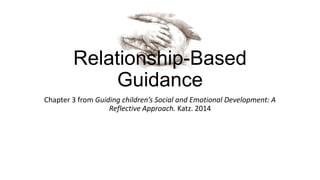
Relationship based guidance
- 1. Relationship-Based Guidance Chapter 3 from Guiding children’s Social and Emotional Development: A Reflective Approach. Katz. 2014
- 2. Book Learning vs. Real Life • Read the case study on p. 36 in your text • Real children and families in real care situations = a dynamic situation
- 4. DAP Revisited • Knowledge and understanding • of child development and learning • of what is individually appropriate • Differences between children • Variations within the child • of what is culturally appropriate • Add to that • Relationship-based – reciprocal and respectful
- 5. Relationship-based guidance • Still Face Experiment • Notice how the mother is attuned to her baby and how her responsiveness or lack of responsiveness impacts the baby’s stress levels. • Which are you? • Sage on the stage? • Guide on the side? See p. 40 in your text Evaluate your personal motivations for choosing to teach
- 6. More terms • As we continue our self-awareness activities, look at the definition of personality on p. 41. How does that differ from temperament? • In the definition of personality, the definition mention “patterns of affect”. What is affect when it’s a noun? • In the definition of temperament in Table 3.1 at the bottom of the page, what does constitutional predisposition mean?
- 7. Reframing Our Thinking • Read the scenarios on p. 41. Which viewpoints are more helpful and supportive for positive relationships with children? • How you respond to children’s behaviors will depend on your “interpretation of and emotional reaction to” those behaviors • Look at the Reframing Activity from the CSEFEL Preschool Training Module • In this activity, you are to write instances during the day that may “push your buttons” or cause you to feel frustrated with a child. Can you think of more positive ways to view what happened? Are you able to reframe your thinking so that you can consider a more proactive and positive response to the behavior? Can you consider ways to help a child improve her social or emotional skill set so that those “annoying” behaviors are diminished?
- 8. CSEFEL • Look at the Reframing Activity from the CSEFEL Preschool Training Module • In this activity, you are to write instances during the day that may “push your buttons” or cause you to feel frustrated with a child. Can you think of more positive ways to view what happened? Are you able to reframe your thinking so that you can consider a more proactive and positive response to the behavior? Can you consider ways to help a child improve her social or emotional skill set so that those “annoying” behaviors are diminished?
- 9. Looking back • Remember goodness-of-fit? • Complete the activity at the bottom of p. 42 and on p. 43 in your text • After comparing your temperament to the temperament of a child in your care, how can you adjust your expectations, responses and the environment to better meet the needs of the child?
- 10. Let’s Evaluate • Look at the scenario on p. 45 in your text. • What steps does Peggy take to better meet the needs of Nolan? • What patterns of behaviors do we have that cause problems for the children in our care? • What patterns of behaviors do we have that are helpful for dealing with the children in our care? • How can we determine what a child’s behaviors are trying to tell us?
- 11. Skill Building - Conversations • Role play – model the use of extended discourse • Two children are playing restaurant and they want you to be their customer • Two children have build a zoo out of the blocks in the block center and have put a variety of animals in various parts of their zoo. • A child is worried because he heard his mommy and daddy yelling last night • A child cries after lunch every day and has to go home. No one knows why.
- 12. Skill Building - Observations • How do young children communicate their inner states? • How do we read their cues? • Nonverbal communication – through body language, eye contact, expressions, play, etc. • Provide variety of opportunities for children to express their inner states. • Know child development to help interpret children’s communication
- 13. Skill Building – Demonstrating Respect • Reciprocity and respect between adult and child enhance compliance and cooperation • Golden rule • How do you “like to be guided and corrected”? • What is the tone of your voice? • Parallel process
Notas del editor
- Personality differs from temperament in that personality is a combination of temperament and experiencesAffect is defined as a “feeling or emotion”; “constitutional predisposition” means “tendency towards characteristics of a person’s body or mind”